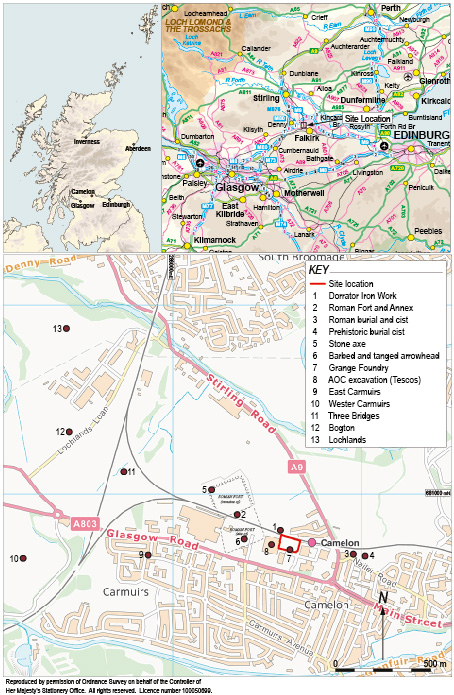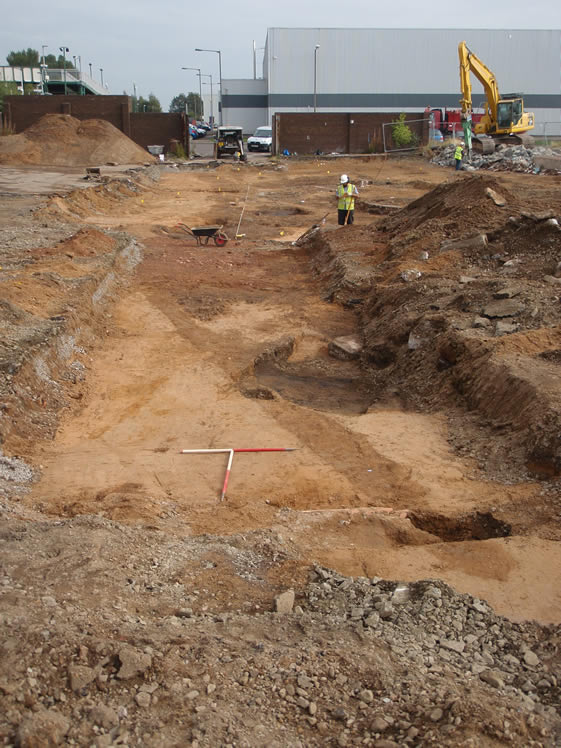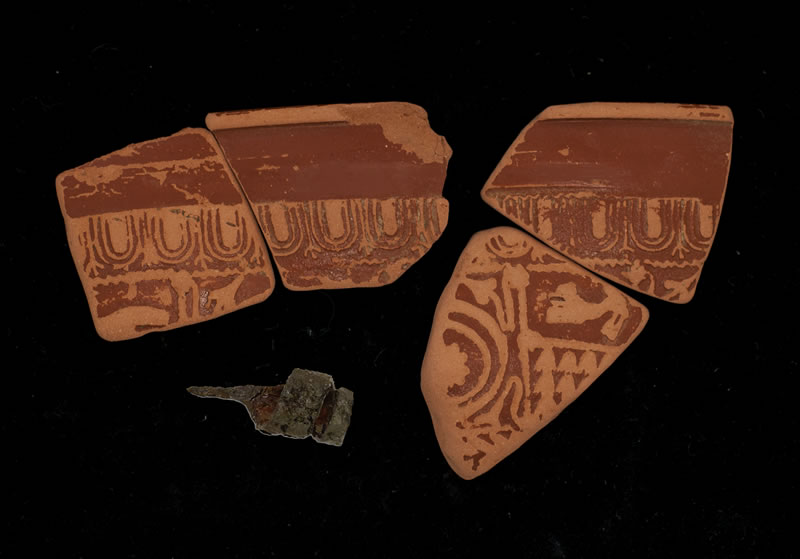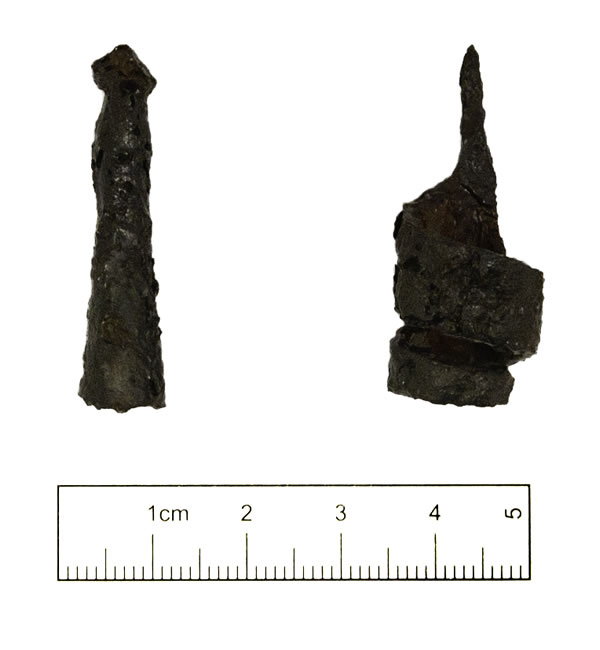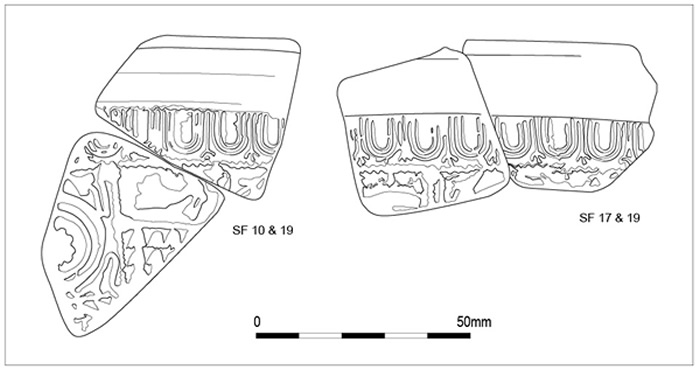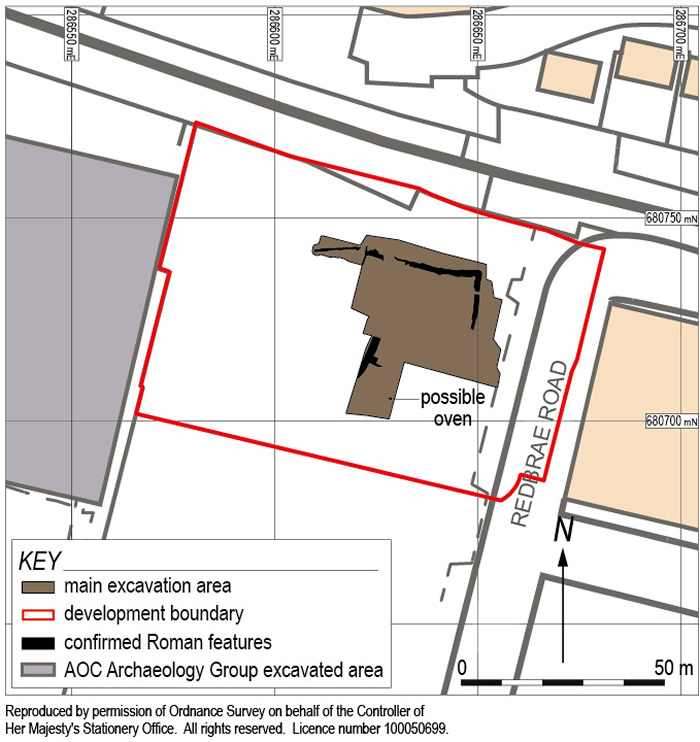A significant assemblage of Roman pottery, metalwork and metalworking debris from a series of pits and ditches sheds new light upon life during the early stages of settlement outside a Roman Fort in central Scotland.
In 2014 GUARD archaeologist Maureen Kilpatrick led an archaeological excavation of an area of ground at Redbrae Road in Camelon near Falkirk, in advance of development. This followed a previous archaeological evaluation that year by fellow GUARD archaeologist Christine Rennie, which had first revealed the presence of significant archaeological features within this site.
Prior to this, a number of other archaeological sites were known in the vicinity, including a range of prehistoric find spots and burials as well as Camelon Roman Fort and a series of ditches and other Roman features that could be dated to the Flavian and Antonine periods of the first and second centuries AD and thought to represent a southern annexe to the Roman fort to the north-west. Previous excavations of an area to the north-west of the Redbrae Road site, by Falkirk Council archaeologist Geoff Bailey, indicated that there could be similar features across the development area, such as military V-shaped ditches, later ditches used as a rubbish dumps and smaller V-shaped ditches of an agricultural origin. Roman ditches were also found by another archaeological company to the immediate west of the Redbrae Road site in another development-led excavation in 2010, though these results are currently unpublished.
The north-east area was stripped of overburden to reveal a sandy subsoil which had been cut into by a number of Roman features including a series of linear ditches representing possible field boundaries, post-holes, a possible bread oven and several pits containing discarded detritus including Roman pottery and industrial waste. A number of modern features, including concrete platforms, areas of blaes, stone filled drains and debris of iron slag, bricks and tile fragments, were also encountered and relate to the twentieth century use of the site as an ironworks.
Twenty-one iron artefacts, including a socketed bolt-head, an ox-goad and hobnails were recovered from the Roman features excavated at Redbrae Road. Fragments of ironworking slag were also recovered from these features.
The socketed bolt-head is a type commonly recovered from Roman military sites. It has previously received various interpretations, including ferrules for the butts of a ballista bolts and arrowheads. However, their differing diameters and lighter weights than ballista bolts make a role as a ferrule unlikely, while their blunt heads made them an unnecessarily inefficient weapon compared to more pointed versions. It is proposed that they may have been practice ballista bolt heads as their blunt head would have made them easier to extract from targets and re-use during the frequent training which must have taken place (and also less deadly should they miss the target).
The ox-goad comprises a spiralled strip with a protruding point at one end. Such artefacts are thought to have been used on the end of a wooden shaft to control oxen pulling a plough. They tend to be Roman in date, though isolated Iron Age examples are also known in southern Britain. Similar artefacts are also known from the medieval period, though these tend to be a simple collar rather than a spiral. Comparable items from Vindolanda were interpreted as pen nibs due to their association with writing tablets but the larger size of the Redbrae Road find is more in keeping with an ox-goad.
Half of the twelve hobnails have traces of mineralised leather layers preserved in the iron corrosion, indicating they were still within leather when deposited. However, none of the hobnails are corroded together, suggesting they are isolated finds from casual losses rather than the result of whole sandals or boots being deposited. Hobnails are ubiquitous in and around Roman sites and are usually by far the most common iron artefact type.
The overwhelming majority of the industrial waste, comprising furnace lining and tap slag, was retrieved from a large pit that also yielded Roman Flavian era pottery sherds and a radiocarbon date of 41 cal BC - 116 cal AD. This pit was in turn sealed beneath a clay-lined ditch that yielded Antonine era Roman pottery from Northern Gaul and a radiocarbon date of 54-215 cal AD. The industrial waste indicates that bloomery smelting of iron was carried out, probably on a relatively small-scale, within or close to the area excavated, and that the waste material was likely dumped in this pit. No evidence for smithing, including primary smithing of the iron bloom, was recovered so it may be surmised that this took place elsewhere.
The excavation recovered 35 sherds of pottery consisting of 13 samian sherds, one mortarium sherd, 21 coarse ware sherds, but no amphorae or other fine wares. The samian sherds, representing two vessels from southern Gaul and Flavian in date, were recovered from just one pit that also yielded the ox-goad.
The environmental samples from the site produced a small mixed assemblage of wood charcoal and cereal grain associated with both pre-Roman and Roman period activity in the southern annexe of Camelon fort. Radiocarbon dating of charcoal from two samples indicated pre-Roman Iron Age activity or very early Roman influence in the area, with two pits producing mixed hearth waste including charcoal and cereal grain as well as Roman pottery. The cereal grain was identified as mainly barley and spelt wheat, with slightly more barley recorded. Oat was found in very low amounts and may have been grown locally as a fodder crop. Charcoal identification suggested mixed deciduous open woodland in the area being exploited for fuel, in particular using hazel, which may also have had a constructional use. Wetter or boggy areas in the vicinity were suggested by alder, birch and willow. Peat and heath land was also being cut for fuel and probably mainly used for drying and cooking cereal grain.
Much debate has surrounded the function of fort annexes, and whether they were used by military personnel only and/or civilian or part civilian in use. It has been suggested that annexes could represent the early stages of the military vici, such as the one found to the immediate east of Inveresk Roman Fort in East Lothian. This was borne out by evidence from excavations at a number of fort annexes in Scotland, including Balmuildy, Castledykes and Mumrills Roman forts, which uncovered material that could be classed as civilian in use. However, evidence of military buildings, bath houses, ovens and industrial activities such as metal working were also present within these spaces suggesting they had multiple uses and were occupied by a variety of different individuals. The recovery of metalworking waste, pottery, agricultural implements and cereal grains and the presence of a possible oven would suggest that the situation was no different at Camelon.
The full results of this research, ARO22: Outside the walls: Excavations within the annexe at Camelon Roman Fort by Maureen Kilpatrick, and funded by Bracewell Stirling Consulting, has just been published and is now freely available to download from the ARO website - www.archaeologyreportsonline.com.

